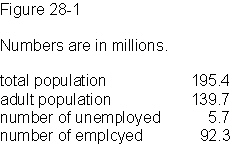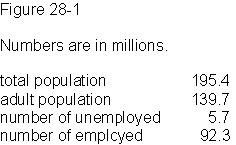True/False
Indicate whether the
sentence or statement is true or false.
|
|
|
1.
|
The natural rate of unemployment is the amount of
unemployment that won't go away on its own, even in the long run.
|
|
|
2.
|
If the unemployment rate falls, we can be certain
that more workers have jobs.
|
|
|
3.
|
In the UK over the twenty years from mid-1980s, the
labour-force participation rate has been rising for women and has been falling for men.
|
|
|
4.
|
The unemployment rate is about the same for the
various demographic groups: men, women, people from non-white ethnic backgrounds, people from white
ethnic backgrounds, young people, old people.
|
|
|
5.
|
A minimum wage is likely to have a greater impact
on the market for skilled workers than on the market for unskilled workers.
|
|
|
6.
|
The presence of a union tends to raise the wage for
insiders and lower the wage for outsiders.
|
|
|
7.
|
A union is a labour cartel.
|
|
|
8.
|
Unions may increase efficiency in some
circumstances because they decrease the cost of bargaining between labour and
management.
|
|
|
9.
|
An efficiency wage is like a minimum wage in that
firms are required by legislation to pay it.
|
|
|
10.
|
Paying efficiency wages tends to increase worker
turnover because workers can get continually higher wages if they change employer
often.
|
|
|
11.
|
Firms may voluntarily pay wages above the level
that balances the supply and demand for workers because the higher wage improves the average quality
of workers that apply for employment.
|
|
|
12.
|
If wages were always at the competitive
equilibrium, there would be absolutely no unemployment.
|
|
|
13.
|
Due to the existence of discouraged workers, the
official unemployment rate may overstate true unemployment.
|
|
|
14.
|
The presence of unemployment insurance tends to
decrease the unemployment rate because recipients of unemployment benefits are not counted in the
labour force.
|
|
|
15.
|
Whenever the wage rises above the competitive
equilibrium, regardless of the source, the result is additional unemployment.
|
Multiple Choice
Identify the
letter of the choice that best completes the statement or answers the question.
|
|
|
16.
|
The amount of unemployment that the economy
normally experiences is known as
a. | the natural rate of
unemployment. | b. | cyclical
unemployment. | c. | efficiency wage
unemployment. | d. | frictional
unemployment. |
|
|
|
17.
|
According to the Office of National Statistics, a
husband who chooses to stay home and take care of the household is
a. | employed. | b. | not in the labour force. | c. | a discouraged
worker. | d. | unemployed. |
|
|
|
18.
|
 Refer to Figure 28-1. The labour force is Refer to Figure 28-1. The labour force isa. | 134.0 million. | b. | none of these answers. | c. | 92.3
million. | d. | 139.7 million. | e. | 98.0 million. |
|
|
|
19.
|
 Refer to Figure 28-1. The unemployment rate is Refer to Figure 28-1. The unemployment rate isa. | 3.2 percent. | b. | 5.7 percent. | c. | 5.8
percent. | d. | Not enough information is available to
answer. | e. | 6.2 percent. |
|
|
|
20.
|
 Refer to Figure 28-1. The labour force participation rate is Refer to Figure 28-1. The labour force participation rate isa. | 47.1 percent. | b. | 65.9 percent. | c. | 50.2
percent. | d. | none of these answers. | e. | 70.2 percent. |
|
|
|
21.
|
A miner who has been unable to find work for so
long that he has stopped looking for work is considered to be
a. | not in the labour force. | b. | not in the adult population. | c. | unemployed. | d. | employed. |
|
|
|
22.
|
Which of the following statements is true of the
UK?
a. | Women tend to have broadly similar unemployment rates as
men. | b. | All of these answers are
true. | c. | The labour force participation rate of men is
rising. | d. | People from non-white ethnic backgrounds have a lower
unemployment rate than people from white ethnic backgrounds. | e. | Most spells of unemployment are long term but most unemployment observed at
any given time is short term. |
|
|
|
23.
|
A minimum wage law tends to
a. | help all teenagers because they receive a higher wage
than they would otherwise. | b. | have no impact on
unemployment as long as it is set above the competitive equilibrium wage. | c. | create more unemployment in high-skill job markets than in low-skill job
markets. | d. | create more unemployment in low-skill job markets than
in high-skill job markets. |
|
|
|
24.
|
Which one of the following types of unemployment
results from the wage being held above the competitive equilibrium wage?
a. | Structural unemployment | b. | Cyclical unemployment | c. | Frictional
unemployment | d. | None of these
answers | e. | Sectoral
unemployment |
|
|
|
25.
|
If, for any reason, the wage is held above the
competitive equilibrium wage,
a. | the quantity of labour supplied will exceed the quantity
of labour demanded and there will be unemployment. | b. | unions will likely strike and the wage will fall to
equilibrium. | c. | the quantity of
labour demanded will exceed the quantity of labour supplied and there will be a labour
shortage. | d. | the quality of workers in the applicant pool will tend
to fall. |
|
|
|
26.
|
A reservation wage is the
a. | maximum wage the firm is willing to
pay. | b. | tip necessary to get a waiter to reserve a
table. | c. | minimum wage the worker is willing to
accept. | d. | competitive equilibrium
wage. |
|
|
|
27.
|
Which of the following government policies would
fail to lower the unemployment rate?
a. | Establishing worker training
programs | b. | Establishing right-to-work
laws | c. | Reducing unemployment
benefits | d. | Establishing employment
agencies | e. | Raising the minimum
wage |
|
|
|
28.
|
Sectoral shifts tend to raise which type of
unemployment?
a. | Structural unemployment | b. | Unemployment due to efficiency wages | c. | Unemployment due to unions | d. | Frictional unemployment |
|
|
|
29.
|
Which of the following is an example of a reason
why firms might pay efficiency wages?
a. | At equilibrium wages, workers sleep when the boss is not
looking because workers are not deeply concerned about being fired. | b. | At equilibrium wages, workers often quit to find better
jobs. | c. | At equilibrium wages, only minimally qualified workers
apply for the job. | d. | At equilibrium
wages, workers cannot afford a healthy diet so they fall asleep at work due to a lack of
energy. | e. | All of these
answers |
|
|
|
30.
|
Some frictional unemployment is inevitable
because
a. | of minimum wage laws. | b. | there are changes in the demand for labour among different
firms. | c. | of unions. | d. | all of these answers | e. | efficiency wages
may hold the wage above the equilibrium wage. |
|
|
|
31.
|
Unions might increase efficiency in the case where
they
a. | raise the wage for insiders above the competitive
equilibrium. | b. | lower the wage of
local outsiders. | c. | offset the market
power of a large firm that is the dominant employer in a region. | d. | threaten a strike but don't actually follow through so there are no lost
hours of work. |
|
|
|
32.
|
Which of the following statements about efficiency
wage theory is true?
a. | Paying above the competitive equilibrium wage tends to
cause workers to shirk their responsibilities. | b. | Firms do not have
a choice about whether they pay efficiency wages or not because these wages are determined by
law. | c. | Paying the lowest possible wage is always the most
efficient (profitable). | d. | Paying above the
competitive equilibrium wage may improve worker health, lower worker turnover, improve worker
quality, and increase worker effort. |
|
|
|
33.
|
Unions tend to increase the disparity in pay
between insiders and outsiders by
a. | increasing the wage in the unionized sector, which may
create a decrease in the supply of workers in the non-unionized sector. | b. | increasing the demand for workers in the unionized
sector. | c. | decreasing the demand for workers in the unionized
sector. | d. | increasing the wage in the unionized sector, which may
create an increase in the supply of workers in the non-unionized
sector. |
|
|
|
34.
|
Which of the following types of unemployment will
exist even if the wage is at the competitive equilibrium?
a. | unemployment due to unions | b. | unemployment due to efficiency wages | c. | frictional unemployment | d. | unemployment due
to minimum-wage laws |
|
|
|
35.
|
If unemployment insurance were so generous that it
paid laid off workers 95 per cent of their regular salary,
a. | frictional unemployment would
fall. | b. | the official unemployment rate would probably understate
true unemployment. | c. | the official
unemployment rate would probably overstate true unemployment. | d. | there would be no impact on the official unemployment
rate. | e. | none of these
answers |
|